Harper’s Bazaar
[India, April 2018 issue]

A simple question spurred Ishaan Jajodia to launch his own publishing house, Bombaykala, last year: Why aren’t young people our age reading more? “People are inundated with so much short-form content, reading something that is 15,000 words becomes a chore,” says the student of Dartmouth College. And he believes that his team—co-founder Kabeer Khurana and new entrants Raj Chhabria and Mrinalini Harchandrai—can effectively tackle the digital age of publishing.
Despite low penetration for e-book access across the country, Jajodia firmly believes that “the future of book selling is online”. As a result, the first thing Bombaykala did was ensure their books were available online. In addition, they’re experimenting with software like Scalar that help authors write long-form, multimedia publications for a digital platform.
They also attempt to draw dwindling attention spans through interactive, on-ground events. As they represent an extensive roster of poets, they’ve dabbled in poetry slams and performances, too. “We try and walk the line between a reading and performance. It might even be on YouTube, Twitter, or Facebook, but people seem to respond well to the form.”
Jajodia, an art history student, tends to focus on academic, non-fiction work (Bombaykala has its own peer-review process for academic writing), history, and classics—but he points out that there are no barriers to entry, or a reading fee, for potential authors. This month, they release their first classic, an anthology of Rudyard Kipling short stories. Harchandrai, the team’s fiction editor and a poet herself, also has her debut work, A Bombay in my Beat, as part of the Bombaykala roster. Other poets they publish include Rochelle D’Silva and Qais Jaunpuri. “Poetry is not a mass market venture. A select section of society will savour it,” says Harchandani. “But good poetry pushes the boundaries of thought and language.”
For both editors, their connection to Mumbai drives their selection—one of the first books they published was A City of Sungazers, a collection of short stories by Queenie Sukhadia. Says Jajodia, “It’s the city of dreams and if Bollywood can do well here then why not books?”
— Butool Jamaal for the April 2018 issue of Harper’s Bazaar India.
Sunday Mid-Day: Indie publishers: A boon for writers
[March 18, 2018]
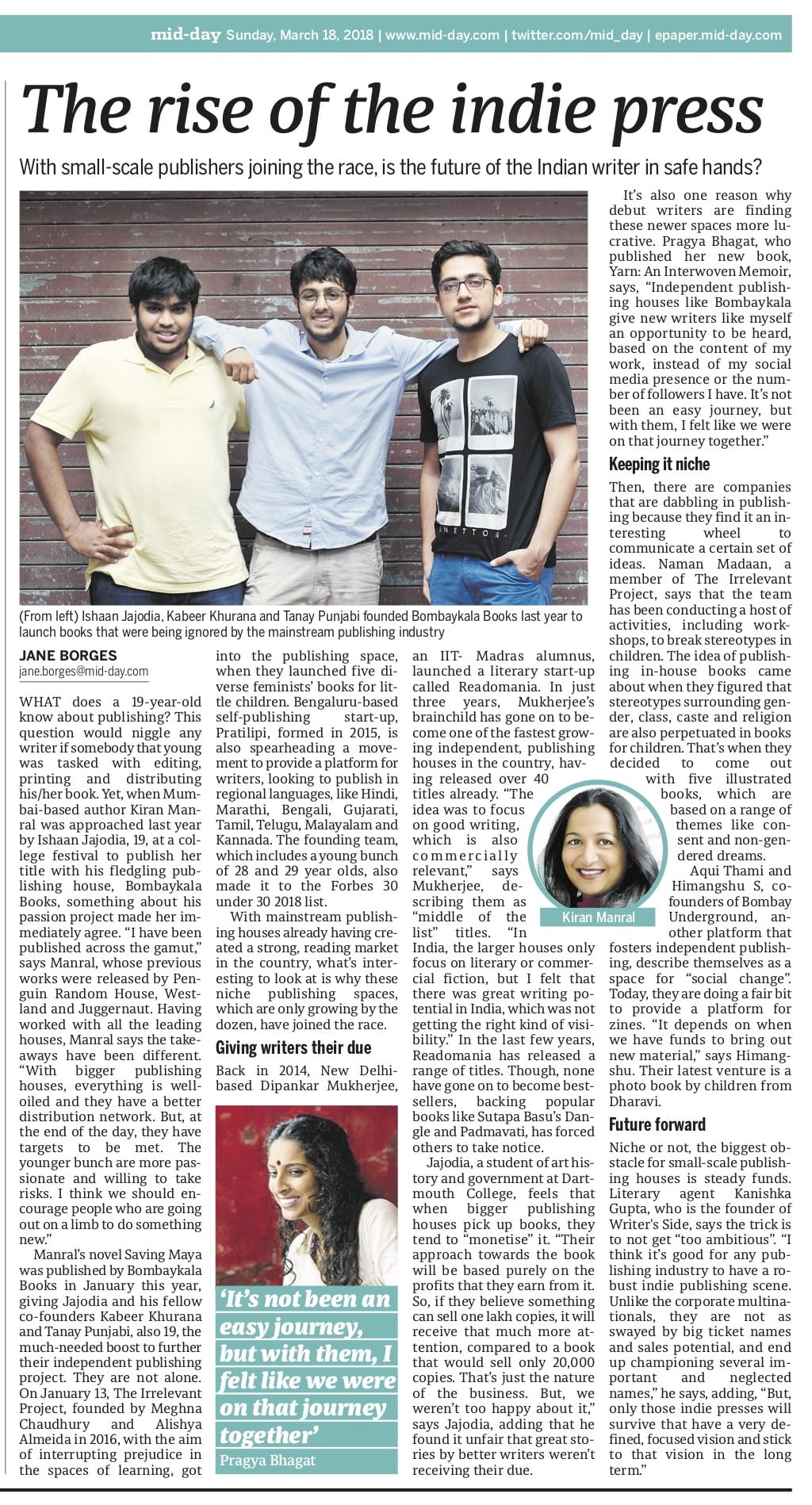
Jajodia, a student of art history and government at Dartmouth College, feels that when bigger publishing houses pick up books, they tend to “monetise” it. “Their approach towards the book will be based purely on the profits that they earn from it. So, if they believe something can sell one lakh copies, it will receive that much more attention, compared to a book that would sell only 20,000 copies. That’s just the nature of the business. But, we weren’t too happy about it,” says Jajodia, adding that he found it unfair that great stories by better writers weren’t receiving their due.
It’s also one reason why debut writers are finding these newer spaces more lucrative. Pragya Bhagat, who published her new book, Yarn: An Interwoven Memoir, says, “Independent publishing houses like Bombaykala give new writers like myself an opportunity to be heard, based on the content of my work, instead of my social media presence or the number of followers I have. It’s not been an easy journey, but with them, I felt like we were on that journey together.”
— Jane Borges for Sunday Mid-Day, March 18, 2018.
Read the full article here: https://www.mid-day.com/articles/indie-publishers-a-boon-for-writers/19210177
Scroll
[February 8, 2018]
How and why did you establish Bombaykala Books?
Bombaykala Books came out of a desire to read more of what I wanted to read. I was unhappy with the current publishing landscape, and the way that commercial pressures shaped the way that publishers looked at books. I’m a bibliophile, not a writer, so it was never about finding an outlet for my own work. There are more forms of capital than just financial capital for a publisher – human, social, symbolic, and intellectual, if we are to take the model that is found in Merchants of Culture (John B Thompson). Another impetus for the course we’re taking is a class I took while at college on the “History of the Book”, by Alexandra Halasz. It opened up a whole new world, a new way of thinking.
— interview conducted by Jaya Bhattacharji Rose for Scroll on Feb 8, 2018, and first published on her blog.
Read the whole interview here: https://scroll.in/article/867639/meet-bombaykala-the-young-book-publishers-ready-to-shake-up-the-industry
India Today: “42 youngsters who are blazing a trail of their own”
[42nd Anniversary Issue, December 2017]
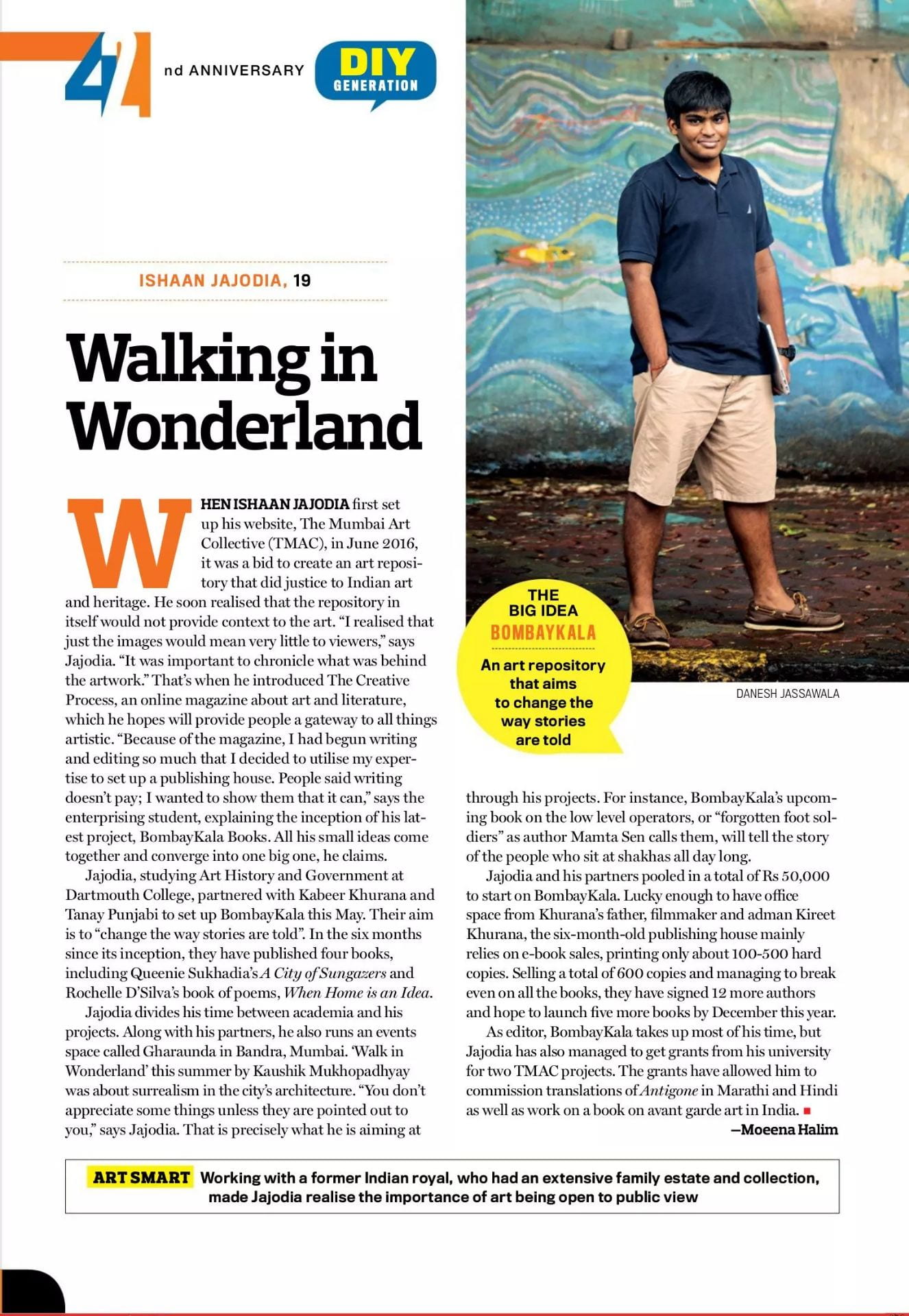
When Ishaan Jajodia first set up his website, The Mumbai Art Collective (TMAC), in June 2016, it was a bid to create an art repository that did justice to Indian art and heritage. He soon realised that the repository in itself would not provide context to the art.
“I realised that just the images would mean very little to viewers,” says Jajodia.
“It was important to chronicle what was behind the artwork.” That’s when he introduced The Creative Process, an online magazine about art and literature, which he hopes will provide people a gateway to all things artistic.
“Because of the magazine, I had begun writing and editing so much that I decided to utilise my expertise to set up a publishing house. People said writing doesn’t pay; I wanted to show them that it can,” says the enterprising student, explaining the inception of his latest project, BombayKala Books.
All his small ideas come together and converge into one big one, he claims.
— Moeena Halim, India Today‘s 42nd anniversary special issue, December 2017. Part of a list of 42 young Indians.
Read the full article here: https://www.indiatoday.in/magazine/nation/story/20171225-ishaan-jajodia-started-website-for-indian-art-and-heritage-1107769-2017-12-15
The Hindu
[Literary Supplement, September 16, 2017]
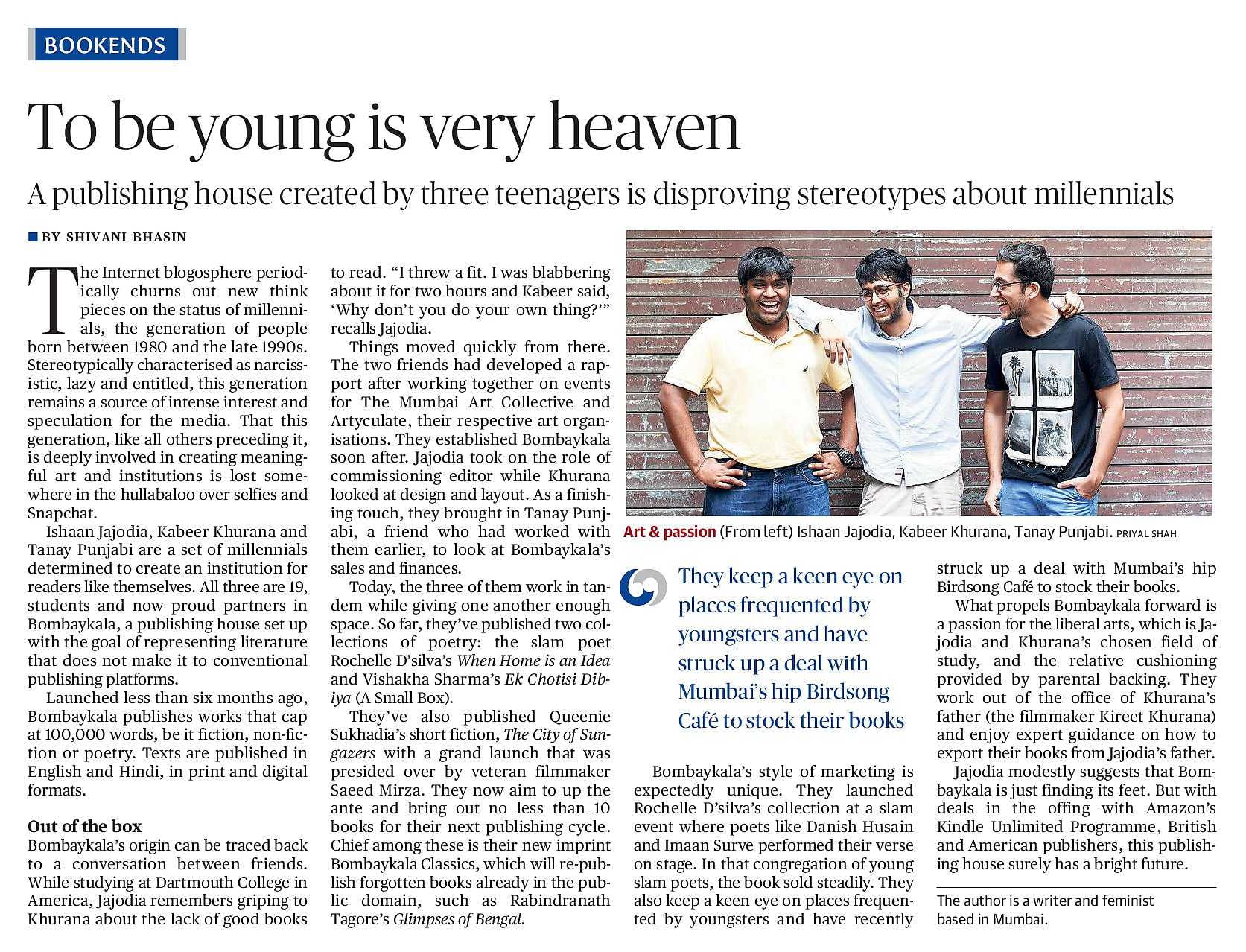
A publishing house created by three teenagers is disproving stereotypes about millennials
The Internet blogosphere periodically churns out new think pieces on the status of millennials, the generation of people born between 1980 and the late 1990s. Stereotypically characterised as narcissistic, lazy and entitled, this generation remains a source of intense interest and speculation for the media. That this generation, like all others preceding it, is deeply involved in creating meaningful art and institutions is lost somewhere in the hullabaloo over selfies and Snapchat.
Ishaan Jajodia, Kabeer Khurana and Tanay Punjabi are a set of millennials determined to create an institution for readers like themselves. All three are 19, students and now proud partners in Bombaykala, a publishing house set up with the goal of representing literature that does not make it to conventional publishing platforms.
Launched less than six months ago, Bombaykala publishes works that cap at 1,00,000 words, be it fiction, non-fiction or poetry. Texts are published in English and Hindi, in print and digital formats.
— Shivani Bhasin for The Hindu, September 16, 2017.
Read the full article here: https://www.thehindu.com/books/to-be-young-is-very-heaven/article19697875.ece
Mid-Day: Publishing house hopes to democratise process of launching books
[July 26, 2017]
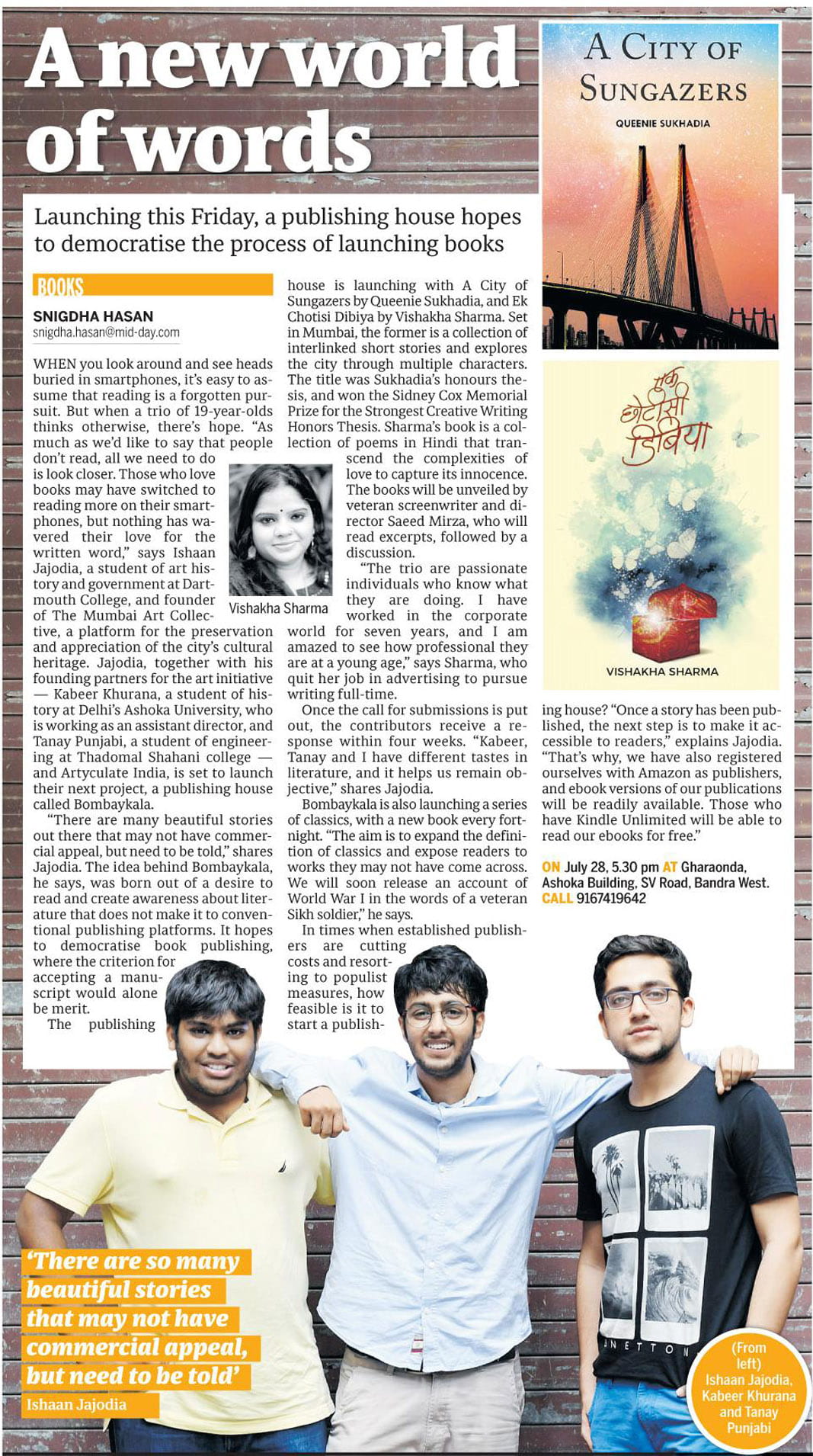
When you look around and see heads buried in smartphones, it’s easy to assume that reading is a forgotten pursuit. But when a trio of 19-year-olds thinks otherwise, there’s hope. “As much as we’d like to say that people don’t read, all we need to do is look closer. Those who love books may have switched to reading more on their smartphones, but nothing has wavered their love for the written word,” says Ishaan Jajodia, a student of art history and government at Dartmouth College, and founder of The Mumbai Art Collective, a platform for the preservation and appreciation of the city’s cultural heritage. Jajodia, together with his founding partners for the art initiative — Kabeer Khurana, a student of history at Delhi’s Ashoka University, who is working as an assistant director, and Tanay Punjabi, a student of engineering at Thadomal Shahani college — and Artyculate India, is set to launch their next project, a publishing house called Bombaykala.
— Snigdha Hassan, Mid Day, July 26, 2017.
Read the full article here: https://www.mid-day.com/articles/publishing-house-hopes-to-democratise-process-of-launching-books/18453165
Mid-Day: The Building Blocks of Bombay
[June 27, 2017]

The collective regularly hosts workshops and talks on topics related to art. “You don’t have to be an architect to attend. The talk is all about learning to appreciate architecture. Appreciation is the first step to recognition,” Jajodia signs off.
— Shraddha Uchil, Mid-Day, June 27, 2017.
Read the whole article here: https://www.mid-day.com/articles/building-blocks-of-mumbai-architecture-talk-mumbai-guide/18373173
DNA: Make sure your college application reflects the person that you are
[May 30, 2017]
At Dartmouth, the classes are small and the student is the focus. The purpose of education here is to promote critical thinking and the skills that come with processing knowledge. This helps you perceive knowledge and epistemology in very different ways.
The amount of times I’ve received special treatment by people because I’m an Ivy League student is startling. There is an underlying assumption that if I was chosen from tens of thousands of applicants to be a member of an elite educational institution, I would be smart. It is helpful when introducing oneself.
The resources that I have access to here, including an original copy of Shakespeare’s full collection of plays (the first folio), the first book printed fully digitally, and art by Rembrandt and James Nachtwey at The Hood Museum of Art are just some of the benefits.
The ability to call upon alumni, too, is spectacular. Alumni networks tend to be tightly knit, and geared towards helping students. The college has given me opportunities that would not be available anywhere else, apart from here.
— interview with Avril Ann-Braganza published in DNA on May 30, 2017.
Read the full piece here: https://www.dnaindia.com/lifestyle/report-make-sure-your-college-application-reflects-the-person-that-you-are-2455221
DNA: Teenpreneurs who are blazing their own trails
[December 16, 2016]

At 18, when most of us are still trying to figure out what career options are available to us, Mumbai-born Ishaan Jajodia decided to take his love for art and photography a notch higher. “In the summer of 2015, I worked with a former Indian royal who had an extensive family heirloom. In 2016, he reached out to me to see if I would be interested in helping him break up and auction off the entire collection. My time with the collection led me to believe that it held greater value as a whole, open to the public to view. I realised that the need of the hour was preservation of what we already had — and that led me to start The Mumbai Art Collective.” Not just art events, Ishaan also publishes a magazine related to art. “I aim to make art more accessible to everyone. I hope to educate people about the story behind art rather than just the art itself.”
Since Ishaan currently goes to Dartmouth University in the United States, he needs to coordinate with his team back in Mumbai. He uses apps such as Telegram, Google Docs etc, to make it all work, but gives priority to his studies as well. “Since art is my passion, I decided to put all my energy in to that which caused my social life to take a hit, but I was more than willing to give it up for something that I loved.” He started The Mumbai Art Collective while he attended Dhirubhai Ambani school in Bombay.
— Aviva Mehta for DNA, Dec 16, 2016.
Read the full article here: https://www.dnaindia.com/lifestyle/report-teenpreneurs-who-are-blazing-their-own-trails-2283297
India Today: Championing Culture
[Cover Story, Simply Mumbai, September 1, 2016]
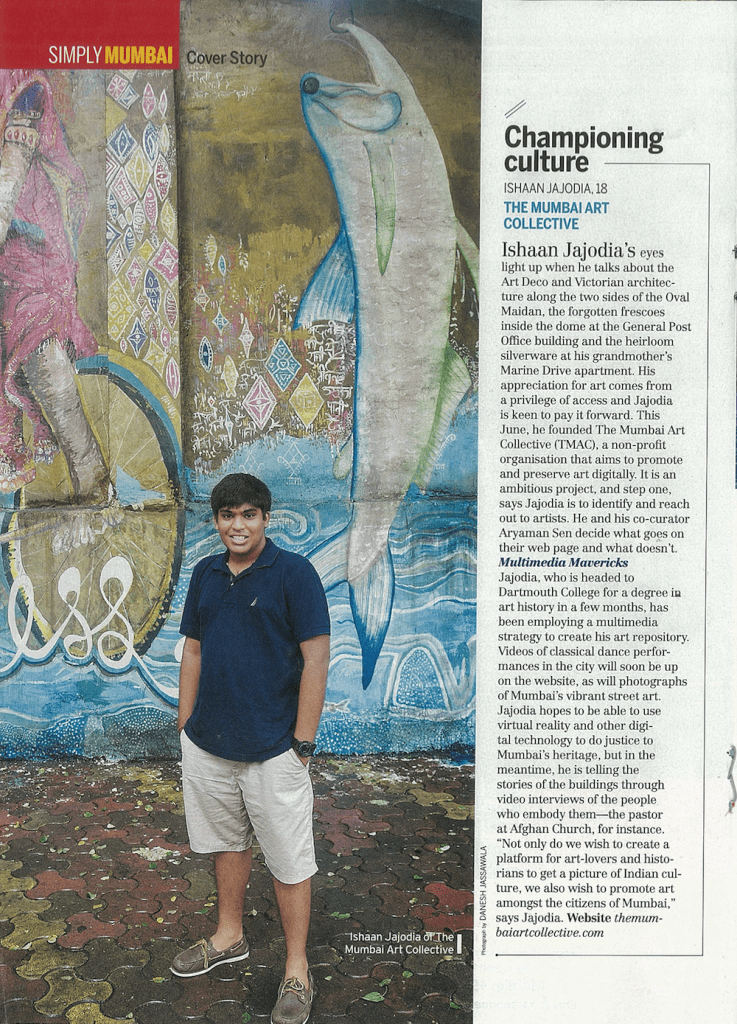
Championing culture
ISHAAN JAJODIA, 18, THE MUMBAI ART COLLECTIVE
Ishaan Jajodia’s eyes light up when he talks about the Art Deco and Victorian architecture along the two sides of the Oval Maidan, the forgotten frescoes inside the dome at the General Post Office building and the heirloom silverware at his grandmother’s Marine Drive apartment. His appreciation for art comes from a privilege of access and Jajodia is keen to pay it forward. This June, he founded The Mumbai Art Collective (TMAC), a non-profit organisation that aims to promote and preserve art digitally. It is an ambitious project, and step one, says Jajodia is to identify and reach out to artists. He and his co-curator Aryaman Sen decide what goes on their web page and what doesn’t.
Multimedia Mavericks
Jajodia, who is headed to Dartmouth College for a degree in art history in a few months, has been employing a multimedia strategy to create his art repository. Videos of classical dance performances in the city will soon be up on the website, as will photographs of Mumbai’s vibrant street art. Jajodia hopes to be able to use virtual reality and other digital technology to do justice to Mumbai’s heritage, but in the meantime, he is telling the stories of the buildings through video interviews of the people who embody them-the pastor at Afghan Church, for instance. “Not only do we wish to create a platform for art-lovers and historians to get a picture of Indian culture, we also wish to promote art amongst the citizens of Mumbai,” says Jajodia. Website themumbaiartcollective.com
— Moeena Halim for India Today, September 2016
Read the article here: https://www.indiatoday.in/magazine/supplement/story/20160829-the-student-revolution-mumbai-art-collective-artyculate-ink-project-jalvruddhi-feeders-733663-2016-08-19
